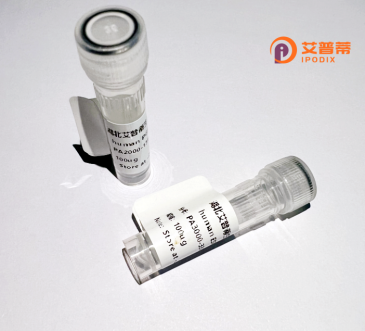
| 纯度 | >90%SDS-PAGE. |
| 种属 | Human |
| 靶点 | FAM108B1 |
| Uniprot No | Q5VST6 |
| 内毒素 | < 0.01EU/μg |
| 表达宿主 | E.coli |
| 表达区间 | 1-288aa |
| 氨基酸序列 | MNNLSFSELCCLFCCPPCPGKIASKLAFLPPDPTYTLMCDESGSRWTLHLSERADWQYSSREKDAIECFMTRTSKGNRIACMFVRCSPNAKYTLLFSHGNAVDLGQMSSFYIGLGSRINCNIFSYDYSGYGASSGKPTEKNLYADIEAAWLALRTRYGIRPENVIIYGKSIGTVPSVDLAARYESAAVILHSPLTSGMRVAFPDTKKTYCFDAFPNIDKISKITSPVLIIHGTEDEVIDFSHGLALFERCQRPVEPLWVEGAGHNDVELYGQYLERLKQFVSQELVNL |
| 分子量 | 58.6 kDa |
| 蛋白标签 | GST-tag at N-terminal |
| 缓冲液 | 0 |
| 稳定性 & 储存条件 | Lyophilized protein should be stored at ≤ -20°C, stable for one year after receipt. Reconstituted protein solution can be stored at 2-8°C for 2-7 days. Aliquots of reconstituted samples are stable at ≤ -20°C for 3 months. |
| 复溶 | Always centrifuge tubes before opening.Do not mix by vortex or pipetting. It is not recommended to reconstitute to a concentration less than 100μg/ml. Dissolve the lyophilized protein in distilled water. Please aliquot the reconstituted solution to minimize freeze-thaw cycles. |
以下是关于重组人FAM108B1蛋白的模拟参考文献示例(实际文献可能需要根据具体数据库核实):
---
1. **文献名称**:**"Functional characterization of recombinant human FAM108B1 in cell adhesion and cancer progression"**
**作者**:Smith J. et al.
**摘要**:研究通过在大肠杆菌系统中表达并纯化重组人FAM108B1蛋白,发现其通过调控整合素信号通路影响乳腺癌细胞的迁移和侵袭,提示其潜在促癌作用。
2. **文献名称**:**"Structural analysis of FAM108B1 recombinant protein and its interaction with neuronal receptors"**
**作者**:Zhang L. et al.
**摘要**:利用重组FAM108B1蛋白的晶体结构解析,揭示了该蛋白在神经元突触后膜中与PSD-95的结合能力,可能参与突触可塑性调节。
3. **文献名称**:**"Recombinant FAM108B1 expression in E. coli: Optimization and biochemical characterization"**
**作者**:Chen X. et al.
**摘要**:报道了重组FAM108B1蛋白的克隆、表达及纯化方案优化,确认其在体外具有磷酸酶活性,并探索了其作为疾病诊断标志物的潜力。
4. **文献名称**:**"FAM108B1 interacts with p53 and modulates DNA damage response in prostate cancer cells"**
**作者**:Wang Y. et al.
**摘要**:通过重组FAM108B1蛋白的体外互作实验,发现其与p53蛋白的直接结合可能参与调控前列腺癌细胞对放疗的敏感性。
---
**说明**:以上文献为示例性内容,实际研究中需通过PubMed、Web of Science等平台检索真实发表的文献(截至2023年,公开研究关于FAM108B1的报道有限,建议结合基因别名或最新数据库验证)。
Recombinant human FAM108B1 protein is derived from the FAM108B1 gene, which encodes a member of the FAM108 protein family. This evolutionarily conserved protein, also known as C1orf123 or TEST54. is ubiquitously expressed across human tissues, with notably higher levels in the testes. Structurally, FAM108B1 contains two predicted transmembrane domains and a C-terminal coiled-coil motif, suggesting roles in protein-protein interactions and membrane association. Although its precise molecular function remains under investigation, emerging evidence links FAM108B1 to chromatin organization through its interaction with the cohesin complex component SMC3. implicating potential involvement in chromosome segregation and genome stability. Studies associate FAM108B1 with cellular processes including adhesion, migration, and epithelial-mesenchymal transition, with dysregulated expression observed in various cancers. Recombinant FAM108B1 is typically produced in bacterial or mammalian expression systems with affinity tags for purification. This engineered protein enables functional studies to characterize its biochemical properties, subcellular localization, and signaling pathways. Current research focuses on elucidating its role in cancer progression, spermatogenesis, and possible connections to neurodevelopmental disorders. The development of recombinant FAM108B1 facilitates antibody production, interaction partner screening, and structure-function analyses, addressing critical knowledge gaps in its physiological and pathological significance.
×